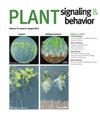Modulation of GCN2 activity under excess light stress by osmoprotectants and amino acids.
IF 3.6
4区 生物学
Q3 BIOCHEMISTRY & MOLECULAR BIOLOGY
引用次数: 1
Abstract
ABSTRACT The protein kinase GCN2 (General Control Nonderepressible2) and its phosphorylation target, the eukaryotic translation initiation factor (eIF)2α represent the core module of the plant’s integrated stress response, a signaling pathway widely conserved in eukaryotes that can rapidly regulate translation in response to stressful conditions. Recent findings indicate that the Arabidopsis thaliana GCN2 protein operates under the command of reactive oxygen species (ROS) emanating from the chloroplast under a variety of abiotic stresses such as excess light. To get deeper insights into the mechanism of GCN2 activation under excess light, we assessed the role of amino acids in view of the classic function of GCN2 as a sensor of amino acid status. Additionally, given that osmoprotectants can counteract ROS-related stresses, we tested their ability to mitigate GCN2 activity. Our results demonstrate that certain amino acids and osmoprotectants attenuate eIF2α-phosphorylation under excess light stress to some degree. Future investigations into the biochemical mechanisms of these natural compounds on GCN2 signaling activity will provide better insights into the GCN2-eIF2α regulation.



渗透保护剂和氨基酸对超光胁迫下GCN2活性的调节。
蛋白激酶GCN2 (General Control Nonderepressible2)及其磷酸化靶点真核生物翻译起始因子(eIF)2α是植物综合应激反应的核心模块,这是一种在真核生物中广泛保守的信号通路,可以在应激条件下快速调节翻译。最近的研究表明,拟南芥GCN2蛋白在多种非生物胁迫(如过度光照)下由叶绿体发出的活性氧(ROS)的指令下工作。鉴于GCN2作为氨基酸状态传感器的经典功能,为了更深入地了解GCN2在超光下激活的机制,我们评估了氨基酸的作用。此外,考虑到渗透保护剂可以抵消ros相关的应激,我们测试了它们降低GCN2活性的能力。我们的研究结果表明,某些氨基酸和渗透保护剂在一定程度上减弱了过度光胁迫下eif2 α-的磷酸化。未来研究这些天然化合物对GCN2信号活性的生化机制将有助于更好地了解GCN2- eif2 α的调控。
本文章由计算机程序翻译,如有差异,请以英文原文为准。
求助全文
约1分钟内获得全文
求助全文
来源期刊

Plant Signaling & Behavior
Agricultural and Biological Sciences-Plant Science
CiteScore
6.00
自引率
3.40%
发文量
111
期刊介绍:
Plant Signaling & Behavior, a multidisciplinary peer-reviewed journal published monthly online, publishes original research articles and reviews covering the latest aspects of signal perception and transduction, integrative plant physiology, and information acquisition and processing.
 求助内容:
求助内容: 应助结果提醒方式:
应助结果提醒方式:


